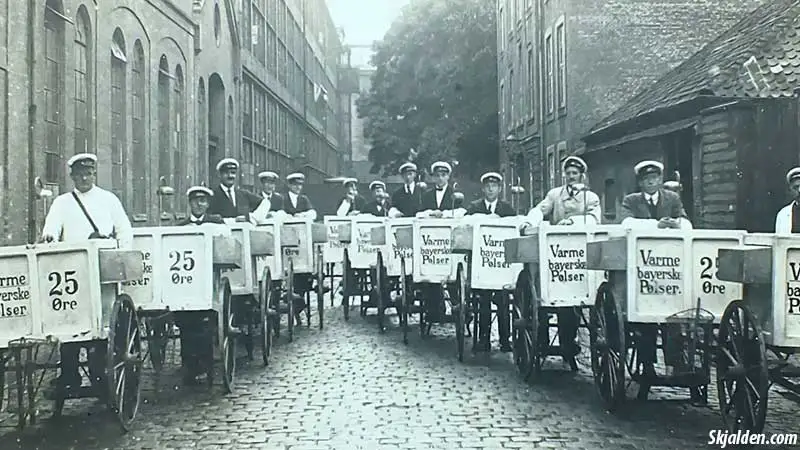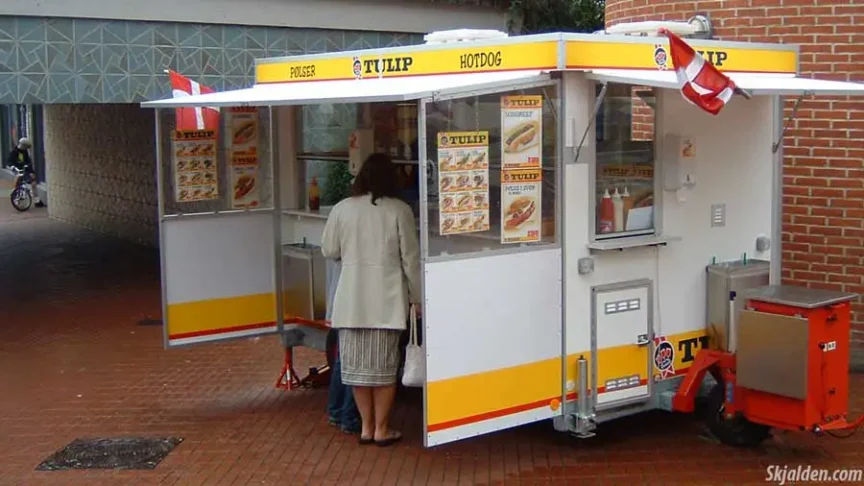Pølsevogn, a term synonymous with Danish street food culture, refers to a mobile hot dog stand that has been a staple in Danish cities for over a century. These stands, which serve hot dogs and bread, have evolved from simple street carts to an integral part of Danish culinary heritage.
The inception of Pølsevogn can be traced back to the streets of major German cities like Berlin before World War I, where the invention of the petroleum burner made it possible to heat pots and containers on the go. This innovation laid the foundation for the unique dining style that Pølsevogn represents.
The Evolution of Pølsevogn
The early Pølsevogn was a humble pull cart with a copper kettle heated by a Primus burner. Around the kettle was a wooden box containing items like sausage bread, which at the time was a round bun. The white-painted box was mounted on a chassis with two large wheels and drawbars. This design reflected the practical needs of street food vending, combining mobility with the ability to serve hot food.
Copenhagen’s municipal authority, on March 4, 1920, became the first in Denmark to permit the sale of hot sausages on the streets. The following year, six mobile Pølsevogne (plural for Pølsevogn) began operating in Copenhagen, marking the official introduction of this street food phenomenon in Denmark. Interestingly, Aarhus had already jumped the gun in 1917, with hot sausages being sold from similar carts.
The golden era of Pølsevogne spanned between 1950 and 1970. During this time, the carts grew larger and more modern. However, they began losing market share to stationary fast-food restaurants from the 1970s onwards.

Pølsevogn in Modern Times
Today, Pølsevogne are still a common sight in major Danish cities. Although their numbers have dwindled from about 700 in the 1970s to just over 100, their presence remains significant. Many have adapted by becoming stationary, losing their wheels in the process. Copenhagen’s Pølsevogne, for instance, have decreased from around 400 in 1950 to about 60 in 2010.
Originally, these carts were mainly operated by independent entrepreneurs. However, today, most are managed by large meat companies like Danish Crown, Steff Houlberg, and Tulip.
A modern Pølsevogn is a versatile structure. It has wheels, and its own motor, and doesn’t depend on external power or water supply, recharging every 19 hours. It can also be a trailer, attached to a vehicle. Notably, only a few municipalities, including Copenhagen, Odense, Slagelse, and Hørsholm, maintain specific regulations for these stands, like the requirement to garage them nightly. Elsewhere, more permanent sausage kiosks have taken over the role of the traditional Pølsevogn.
In recent years, the menu at these stands has expanded to include organic and vegetarian options, catering to a broader range of dietary preferences.
Leje Af Pølsevogn: A Trend in Danish Celebrations
An interesting trend in Denmark is the renting of Pølsevogne for private events, such as parties or as a work reward. ‘Leje af Pølsevogn,’ meaning ‘rent a hot dog stand,’ has become a popular service. These rentals allow individuals to bring a piece of Danish street food tradition to their special occasions, offering a unique and nostalgic dining experience.
The Historical Significance
While Pølsevogne in Denmark found their footing in the early 20th century, their conceptual roots lie in neighboring Sweden and Norway. Around 1900, street sausage sales were already common in Göteborg, Sweden, and Kristiania (now Oslo), Norway. In contrast, Denmark’s København stadepladser (marketplaces) were bustling with trade, but hot sausages were conspicuously absent.
The story of Pølsevogn in Denmark is intertwined with the stories of influential figures like Charles Svendsen Stevns, a Danish musician and entrepreneur. Stevns, inspired by the street food culture he witnessed in Berlin and Scandinavia, was the driving force behind introducing Pølsevogne to Copenhagen.
Despite initial rejections, his persistence paid off when, in 1920, the city’s municipal authority granted permission to operate these stands. This decision was partly influenced by the then-conservative mayor Ernst Kaper, who saw Pølsevogne as a means to challenge the high prices of restaurants.
Following the initial setup of six carts in Copenhagen, the concept rapidly spread across Denmark. The Pølsevogn became a symbol of accessible and affordable street food, contrasting the more expensive dining options of that era. The carts evolved from simple wooden structures to more sophisticated and sheltered designs, reflecting the changing needs of their operators.
Over the years, the Pølsevogn has witnessed ups and downs, facing stiff competition from grill and burger bars post-World War II and undergoing significant transformations. Nevertheless, it has remained an iconic element of Danish street food culture, evolving yet preserving its traditional charm.
Today, Pølsevogne are not only a culinary attraction but also a piece of living history, embodying Denmark’s rich street food culture and social dynamics. They continue to serve as gathering spots where people from all walks of life come together over a shared love for Danish hot dogs, making them an enduring symbol of Danish gastronomy.
